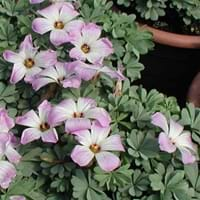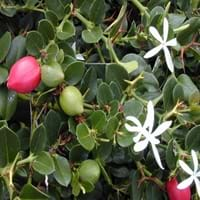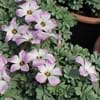Life Span
Perennial
Perennial
Type
Bulb or Corm or Tuber
Shrub
Origin
Argentina, Chile
Southern Africa
Types
Not available
Carissa Carandas
Habitat
Shaded sites, Woodlands
Coastal bush land, Sandy areas
USDA Hardiness Zone
7-9
9-11
Sunset Zone
21,22
H2, 16, 17, 18, 19, 20, 21, 22, 23, 24
Habit
Clump-Forming
Cushion/Mound-forming
Flower Color
White, Fuchsia, Rose, Violet
White
Flower Color Modifier
Bicolor
Not Available
Fruit Color
Not Available
Hot Pink, Magenta, Purple, Red
Leaf Color in Spring
Light Green, Gray Green
Dark Green
Leaf Color in Summer
Light Green
Dark Green
Leaf Color in Fall
Several shades of Green
Dark Green
Leaf Color in Winter
Light Green
Dark Green
Leaf Shape
Heart-shaped
Oval to roundish
Plant Season
Spring, Summer, Fall
Spring, Summer, Fall, Winter
Sunlight
Full Sun, Partial Sun, Partial shade
Full Sun, Partial Sun
Type of Soil
Clay, Loam, Sand
Loam, Sand
The pH of Soil
Neutral
Acidic, Neutral
Soil Drainage
Well drained
Well drained
Bloom Time
Late Spring, Early Summer, Summer, Late Summer, Early Fall, Fall
Indeterminate
Tolerances
Drought
Drought
Where to Plant?
Ground, Pot
Ground, Pot
How to Plant?
Divison, Seedlings
Seedlings
Plant Maintenance
Medium
Medium
Watering Requirements
Water in the early morning hours
Average Water Needs
In Summer
Lots of watering
Lots of watering
In Spring
Moderate
Moderate
In Winter
Average Water
Average Water
Soil pH
Neutral
Acidic, Neutral
Soil Type
Clay, Loam, Sand
Loam, Sand
Soil Drainage Capacity
Well drained
Well drained
Sun Exposure
Full Sun, Partial Sun, Partial shade
Full Sun, Partial Sun
Pruning
Remove damaged leaves, Remove dead branches, Remove dead leaves
Remove damaged leaves, Remove dead branches, Remove dead leaves
Fertilizers
All-Purpose Liquid Fertilizer
Equal amount of N,P,K
Pests and Diseases
Red blotch
Aphids
Plant Tolerance
Drought
Drought
Flower Petal Number
Single
Single
Foliage Texture
Medium
Medium
Foliage Sheen
Matte
Glossy
Allergy
Asthma, Depression
Mildly Toxic
Aesthetic Uses
Cottage Garden, Formal Garden, Ground Cover, Showy Purposes
along a porch, deck or patio, Ground Cover, small hedge
Beauty Benefits
Not Available
Not Available
Environmental Uses
Air purification
Air purification
Medicinal Uses
Not Available
Iron, Potassium, Vitamin C
Part of Plant Used
Flowers
Fruits
Other Uses
Basketary
Cake, Jam, Jelly, Sauces
Used As Indoor Plant
No
Yes
Used As Outdoor Plant
Yes
Yes
Garden Design
Alpine, Container, Houseplant, Mixed Border, Rock Garden / Wall
Bedding Plant, Container, Edging, Edible, Foundation, Groundcover, Hedges, Topiary, Bonsai, Espalier, Tropical
Botanical Name
OXALIS adenophylla
CARISSA macrocarpa 'Emerald Blanket'
Common Name
Chilean Wood Sorrel, Pink Buttercups, Pink Carpet Oxalis, Silver Shamrock
Large Num-Num
In Hindi
Chilean Wood Sorrel
नेटाल बेर
In German
Chilean Wood Sorrel
Natal Plum
In French
Chilean Wood Sorrel
natal Plum
In Spanish
Chilean Wood Sorrel
Ciruela Natal
In Greek
Chilean Wood Sorrel
Natal Plum
In Portuguese
Chilean Wood Sorrel
Natal Plum
In Polish
Chilean Wood Sorrel
Natal Plum
In Latin
Chilean Wood Sorrel
Natal Plum
Phylum
Magnoliophyta
Magnoliophyta
Class
Magnoliopsida
Magnoliopsida
Order
Oxalidales
Gentianales
Family
Oxalidaceae
Apocynaceae
Clade
Angiosperms, Eudicots, Rosids
Angiosperms, Asterids, Eudicots
Tribe
Not Available
Carisseae
Subfamily
Not Available
Rauvolfioideae
Number of Species
Not Available
Properties of Chilean Wood Sorrel and Natal Plum
Wondering what are the properties of Chilean Wood Sorrel and Natal Plum? We provide you with everything About Chilean Wood Sorrel and Natal Plum. Chilean Wood Sorrel doesn't have thorns and Natal Plum doesn't have thorns. Also Chilean Wood Sorrel does not have fragrant flowers. Chilean Wood Sorrel has allergic reactions like Asthma and Depression and Natal Plum has allergic reactions like Asthma and Depression. Compare all the properties and characteristics of these two plants. Find out which of these plant can be used as indoor plant. If you are interested to decorate your house and garden, find out aesthetic uses, compare them and select the plant which will beautify your surrounding. Along with beautification, try comparing medicinal and edible uses of Chilean Wood Sorrel and Natal Plum and you can choose the plant having best and most benefits.
Season and Care of Chilean Wood Sorrel and Natal Plum
Season and care of Chilean Wood Sorrel and Natal Plum is important to know. While considering everything about Chilean Wood Sorrel and Natal Plum Care, growing season is an essential factor. Chilean Wood Sorrel season is Spring, Summer and Fall and Natal Plum season is Spring, Summer and Fall. The type of soil for Chilean Wood Sorrel is Clay, Loam, Sand and for Natal Plum is Loam, Sand while the PH of soil for Chilean Wood Sorrel is Neutral and for Natal Plum is Acidic, Neutral.
Chilean Wood Sorrel and Natal Plum Physical Information
Chilean Wood Sorrel and Natal Plum physical information is very important for comparison. Chilean Wood Sorrel height is 10.20 cm and width 15.20 cm whereas Natal Plum height is 60.00 cm and width 60.00 cm. The color specification of Chilean Wood Sorrel and Natal Plum are as follows:
Chilean Wood Sorrel flower color: White, Fuchsia, Rose and Violet
Chilean Wood Sorrel leaf color: Light Green and Gray Green
Natal Plum flower color: White
- Natal Plum leaf color: Dark Green
Care of Chilean Wood Sorrel and Natal Plum
Care of Chilean Wood Sorrel and Natal Plum include pruning, fertilizers, watering etc. Chilean Wood Sorrel pruning is done Remove damaged leaves, Remove dead branches and Remove dead leaves and Natal Plum pruning is done Remove damaged leaves, Remove dead branches and Remove dead leaves. In summer Chilean Wood Sorrel needs Lots of watering and in winter, it needs Average Water. Whereas, in summer Natal Plum needs Lots of watering and in winter, it needs Average Water.





